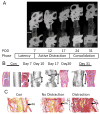Overview of biological mechanisms and applications of three murine models of bone repair: closed fracture with intramedullary fixation, distraction osteogenesis, and marrow ablation by reaming
- PMID: 25727198
- PMCID: PMC4358754
- DOI: 10.1002/9780470942390.mo140166
Overview of biological mechanisms and applications of three murine models of bone repair: closed fracture with intramedullary fixation, distraction osteogenesis, and marrow ablation by reaming
Abstract
Fractures are one of the most common large-organ, traumatic injuries in humans, and osteoporosis-related fractures are the fastest growing health care problem of aging. Elective orthopedic surgeries of the bones and joints also represent some of most common forms of elective surgeries performed. Optimal repair of skeletal tissues is necessary for successful outcomes of these many different orthopedic surgical treatments. Research focused on post-natal skeletal repair is therefore of immense clinical importance and of particular relevance in situations in which bone tissue healing is compromised due to the extent of tissue trauma or specific medical co-morbidities. Three commonly used murine surgical models of bone healing, closed fracture with intramedullary fixation, distraction osteogenesis (DO), and marrow ablation by reaming, are presented. The biological aspects of these models are contrasted and the types of research questions that may be addressed with these models are presented.
Keywords: distraction osteogenesis; fracture; marrow ablation; murine models; orthopedic surgery.
Copyright © 2015 John Wiley & Sons, Inc.
Figures




References
-
- Abou-Khalil R, Colnot C. Cellular and molecular bases of skeletal regeneration: What can we learn from genetic mouse models? Bone. 2014;64:211–221. - PubMed
-
- Aronson J, Good B, Stewart C, Harrison B, Harp J. Preliminary studies of mineralization during distraction osteogenesis. Clinical orthopaedics and related research. 1990;250:43–49. - PubMed
-
- Aronson J. Experimental and clinical experience with distraction osteogenesis. The Cleft palate-craniofacial journal. 1994;31:473–482. - PubMed
-
- Balogh ZJ, Reumann MK, Gruen RL, Mayer-Kuckuk P, Schuetz MA, Harris IA, Gabbe BJ, Bhandari M. Advances and future directions for management of trauma patients with musculoskeletal injuries. The Lancet. 2012;380:1109–1119. - PubMed
Publication types
MeSH terms
Grants and funding
LinkOut - more resources
Full Text Sources
Other Literature Sources
Medical

